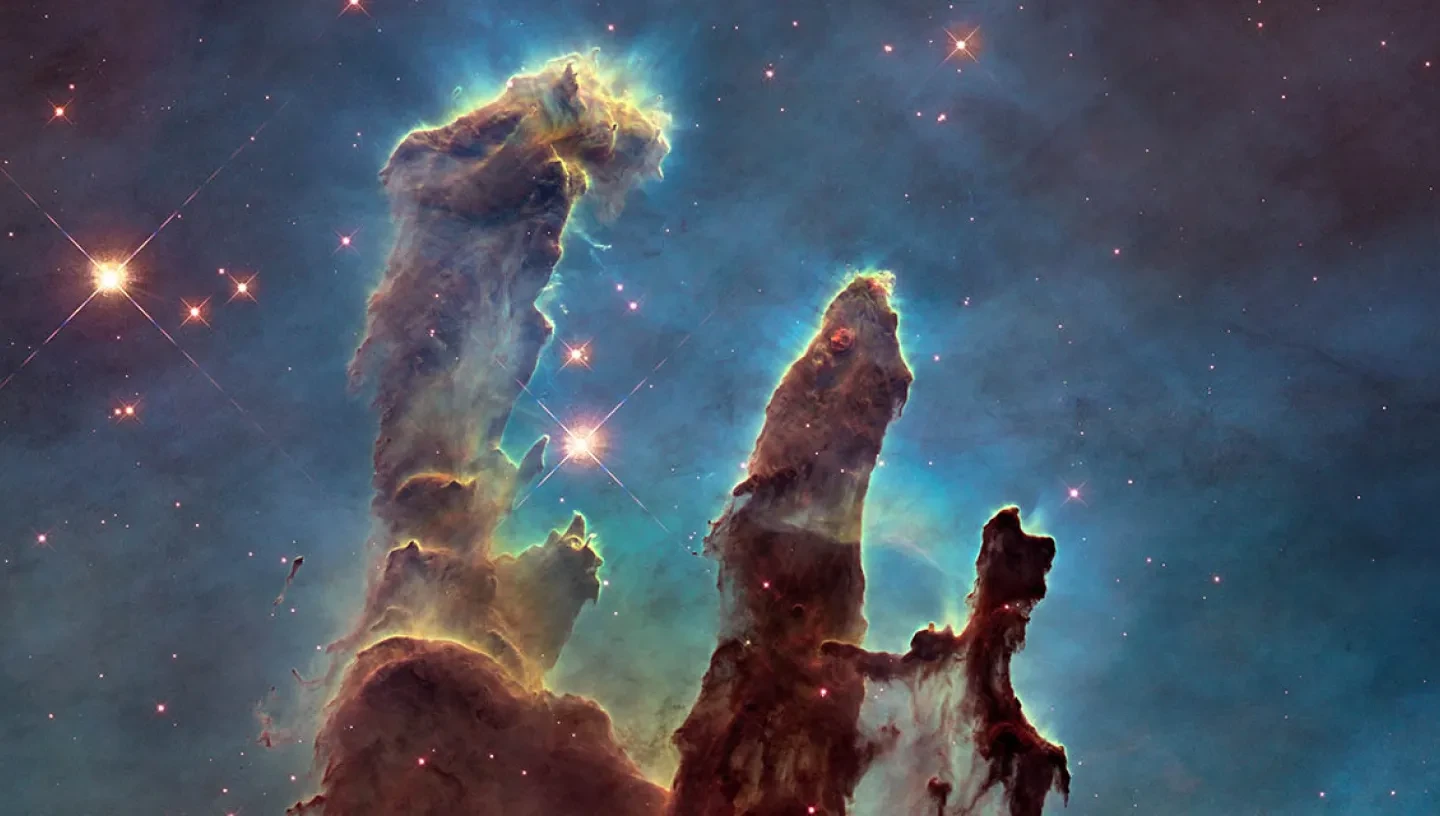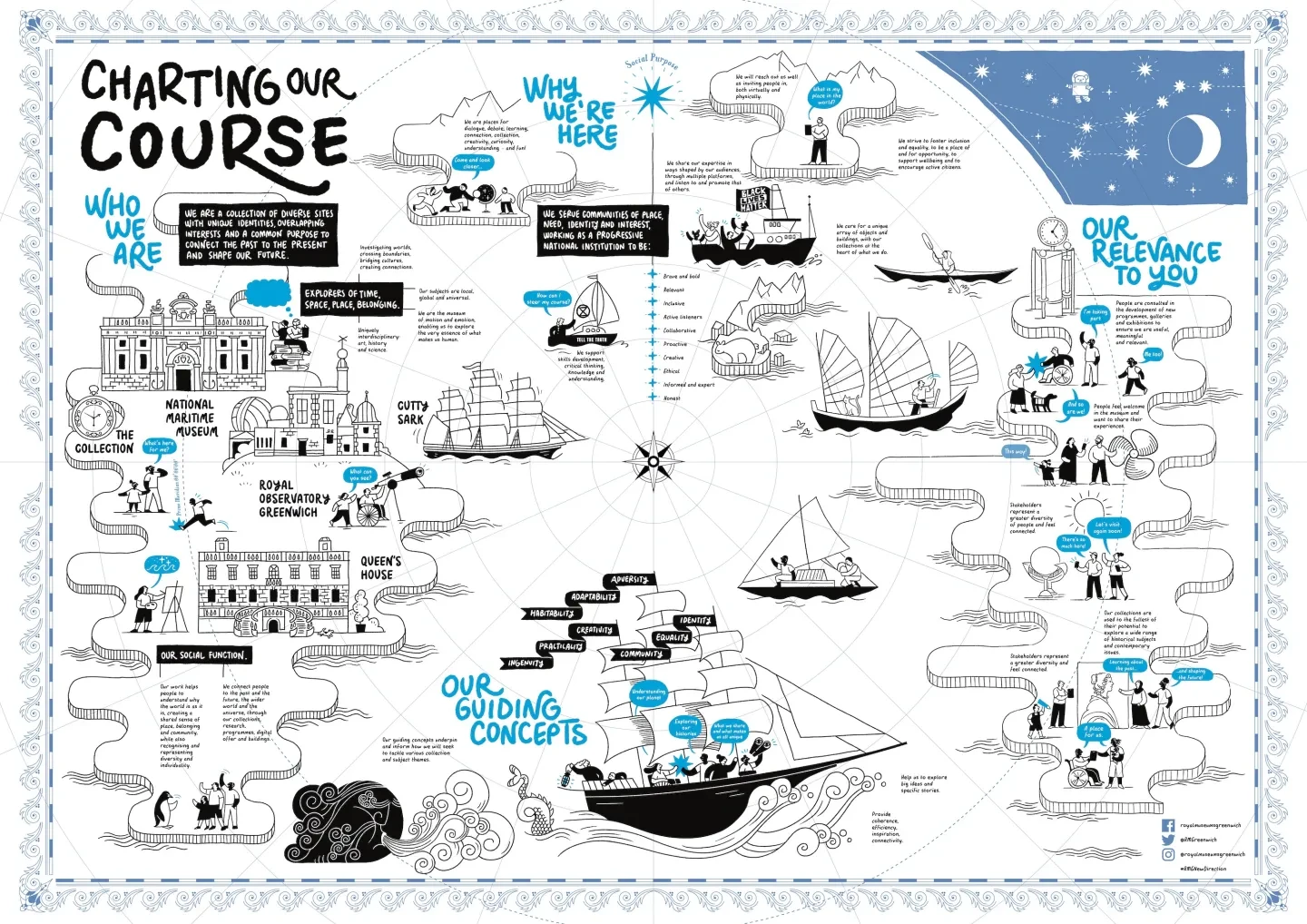
The Royal Museums Greenwich plan 2025-2029
Building Reach, Reputation and Resilience
Charting our course
Our key content themes are articulated in pictorial form here, and the narrative below provides further information.
What we do: our function in society
- Museums are places that hold collections, gathering together objects, historical information and memories. Royal Museums Greenwich’s collections are held in trust for the nation. Through our collections, we connect the past to people in the present-day; they can also help us to think about and shape the future.
- We can help people to understand why the world is as it is, creating a shared sense of place, belonging and community, while also recognising and representing diversity and individuality.
- We strive to foster inclusion and equality, to be a place of and for opportunity, to support wellbeing and to encourage active citizens. We want everyone to feel welcome and see themselves at Royal Museums Greenwich.
- We share our expertise in ways shaped by our audiences, through multiple platforms, and listen to and promote that of others.
- We care for a unique array of objects and buildings, with our collections at the heart of what we do.
- We will strive to tell histories more fully, recognising different perspectives and working with stakeholders to be honest about the past.
Who we are: Royal Museums Greenwich
- We are a collection of diverse sites with unique identities, overlapping interests and a common purpose.
- We are explorers of time, space, place and belonging. Our collections and subjects are about investigating worlds, crossing boundaries, bridging cultures, and creating connections. We are a place to explore the very essence of what makes us human.
- Our collections reach across continents, cultural divides, tumultuous seas and cosmic voids. Through our institution, we have a uniquely interdisciplinary potential – art, history and science – which we can tackle separately and in dialogue with each other.
- Our subjects are local, global and universal – they help us to pose big questions about the universe we live in, the planet we live on and its people.
Why we’re here: our social purpose
- Royal Museums Greenwich has a social purpose at its heart – to serve our communities and stakeholders in line with our function as museums and heritage sites.
- We want to be a progressive national museum – brave and bold, relevant, inclusive, collaborative, proactive, ethical, informed and expert. We will listen and learn, evaluate and consult, working together to be a place by and for our audiences.
- We will strive to tell histories more fully, recognising different perspectives and working with stakeholders to be honest about the past, giving an equality of voice and recognising intersecting identities.
- We will support skills development, critical thinking, knowledge and understanding.
- Our primary aim will be to be relevant and meaningful, both reaching out and inviting people in, welcoming all and supporting their wellbeing.
- We will have clear timelines and a strategic plan. This will involve mapping the journey in the following ways: in vision (1–5 years; clear sense of outputs); on the horizon (5–10 years; a range of possibilities); in the imagination (10–15 years; blue- sky thinking and experimentation). This will enable us to enhance our reach and reputation, and attract funding.
Guiding concepts
Interpreted through our collections and shared expertise, these are the filter through which potential activities (e.g., exhibitions, programmes, publications) are viewed.
They will help us to move from big ideas to specific stories and content, and provide coherence, efficiency, inspiration, and connectivity.
Adversity, adaptability and habitability
Our watery planet is uniquely situated and suited to the evolution of life. Human beings, originally from the tropics of Africa, have populated almost every corner of the globe. In doing so, we have adapted to the adversities of climate and the harshness of physical environments – from scorching deserts to frozen tundra, from dense jungles to the open ocean – exploring, surviving, adapting and thriving. Many great migrations – across the Pacific Ocean, for example – involved long sea voyages, posing unique challenges and requiring people to work with natural systems like tides, currents and winds. Ultimately, our ability to adapt has led us the ends of the Earth and to venture beyond into space, where we look for life and the potential for human settlement in other places. But from the irradiated waste of orbital space to the barren surface of Mars and beyond, it seems nowhere is quite like home. However, the human drive for expansion and the inexorable exploitation of the natural world on an industrial scale have their costs. Environmental damage, pollution and the climate crisis are direct results of this activity. Together they have created new and worsening adversities, including melting ice caps and rising seas, which threaten the habitability of this planet and the future survival of humanity. Can humans move from an expansionary mode to living within the sustainable limits of the environment?
Identity, diversity and community
Our identities make us human. They shape who we are, forging and sustaining communities at personal, local, national and global levels, bringing us together and setting each of us apart. Communities of identity embrace and cut across gender, race, class, ability, sexuality, life experience and religious belief. They foster bonds of friendship, wellbeing, imagination and an essential sense of belonging. Even when looking out into space, we strive for connection and meaning, asking ourselves are we alone? Our diversity also brings inequality and difference into sharp relief. Barriers of prejudice and discrimination perpetuate both privilege and disadvantage, creating fear, resentment and entitlement. Our collections have often been shaped by those with the most power, making them partial and representative only of particular perspectives, diminishing the agency and contributions of many others. However, by exploring, appreciating and celebrating individual and collective diversity, we can nurture greater equality, understanding and accessibility, helping everyone to find their place in our museum, in our world and in the wider universe.
Creativity, curiosity and ingenuity
Humans are uniquely curious and creative beings. We explore, seek to understand and respond imaginatively to the world around us, producing works of art that reflect upon and question our humanity. We rise to the challenges presented by changing circumstances and new environments, finding inventive ways to solve problems through the application of science and technology.
For many people, the sea and the sky represent two vast canvases of imaginative possibility, inspiring innovation in art and science in equal measure. For artists and writers, depicting and describing the restless, translucent sea tests their skills and creativity. At the same time, overcoming the difficulties and dangers of a sea voyage requires ingenious practical solutions. Doing so has allowed us to access the far reaches of the globe, fulfilling the instinctive human hunger for knowledge and understanding. Our ingenuity has helped to unlock some of the secrets of the night sky, allowing advances to be made in navigation, timekeeping, astronomy and space exploration. However, as scientists probe deeper into the seeming infinity of space, we are increasingly questioning our place in the Universe and the precarious and precious nature of life on Earth.
How will we know if we’re succeeding?
- People will feel welcome in the museum and want to share their experiences
- People are consulted in the development of new programmes, galleries and exhibitions to ensure we are useful, meaningful and relevant.
- The museum will be embedded in its community and part of people’s everyday lives, fulfilling our local, national and international potential.
- Stakeholders represent a greater diversity of people and feel connected.
- Funders will want to share in our success; our reach and reputation will speak for themselves.
- We will be the leaders in the understanding of Britain’s history, legacies and future.
- Our collections will be used to the fullest of their potential to explore a wide range of historical subjects and contemporary issues, often connecting the two.
- Everyone knows what we do, who we are and why it’s important.
